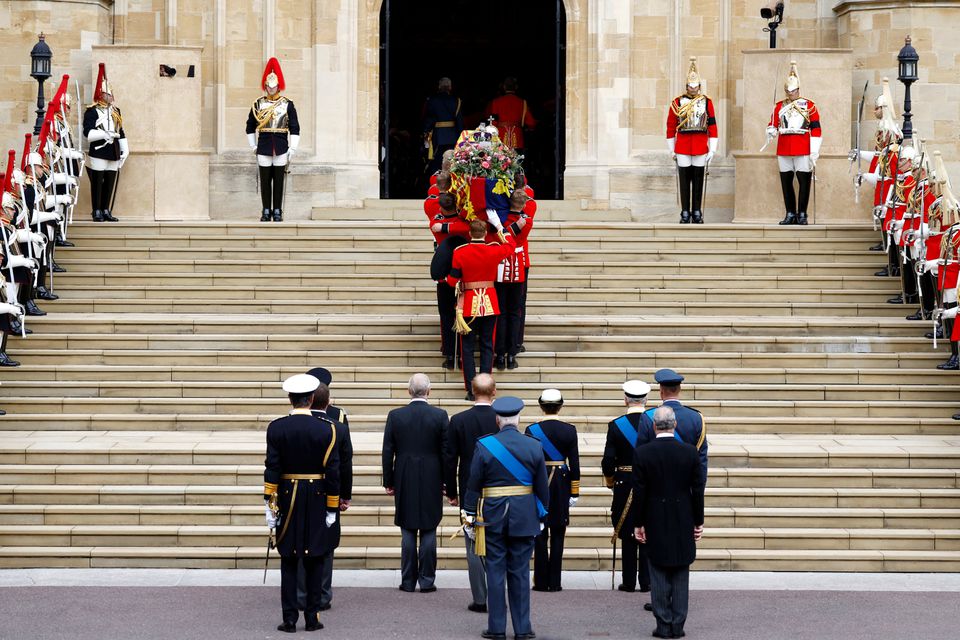Queen Elizabeth’s coffin lowered into vault ahead of private burial
 Queen Elizabeth’s coffin was lowered into a vault at Windsor Castle, her final resting place, on Monday after a day of inimitable pageantry that drew world leaders to her funeral.
Queen Elizabeth’s coffin was lowered into a vault at Windsor Castle, her final resting place, on Monday after a day of inimitable pageantry that drew world leaders to her funeral.
It also brought huge crowds to the streets to say farewell to a revered monarch.
Hundreds of thousands of well-wishers lined the route her hearse took from London, throwing flowers, cheering and clapping as it passed from the city to the English countryside that she so loved much.
Many more had crammed into the capital to witness the procession and funeral, in a moving tribute to Britain’s longest-serving monarch who won global respect during her 70 years on the throne.
Inside the majestic Westminster Abbey where the funeral was held, some 500 presidents, including Ghana’s President Nana Addo Dankwa Akufo-Addo and President Joe Biden of the United States, prime ministers, foreign royal family members and dignitaries, were among the 2,000 congregation.
Later the attention switched to St George’s Chapel in Windsor Castle, where some 800 guests attended a committal service ahead of her burial.
It concluded with the crown, orb and sceptre – symbols of the monarch’s power and governance – being removed from the coffin and placed on the altar.
The Lord Chamberlain, the most senior official in the royal household, then broke his ‘Wand of Office’, signifying the end of his service to the sovereign, and placed it on the casket before it slowly descended into the royal vault.
As the congregation sang the national anthem, King Charles appeared to be fighting back tears.
Later in the evening, in a private family service, the coffin of Elizabeth and her husband of more than seven decades, Prince Philip, who died last year aged 99, will be buried together in the same chapel where her parents and sister, Princess Margaret, also rest.
It was in the same vast building that the queen was photographed mourning Philip alone during the pandemic lockdown, reinforcing the sense of a monarch in synch with her people during a testing time.
At the funeral, Justin Welby, the Archbishop of Canterbury, told those present that the grief felt by so many across Britain and the wider world reflected the late monarch’s “abundant life and loving service”.
“Her late majesty famously declared on a 21st birthday broadcast that her whole life would be dedicated to serving the nation and Commonwealth,” he said.
“Rarely has such a promise been so well kept. Few leaders receive the outpouring of love that we have seen.”
Music that played at the queen’s wedding in 1947 and her coronation six years later again rang out.
The coffin entered to lines of scripture set to a score used at every state funeral since the early 18th century.
After the funeral, her flag-draped casket was pulled by sailors through London’s streets on a gun carriage in one of the largest military processions seen in Britain, involving thousands of members of the armed forces dressed in ceremonial finery.
They walked in step to funeral music from marching bands, while in the background the city’s famous Big Ben tolled each minute.
King Charles and other senior royals followed on foot.
The casket was taken from Westminster Abbey to Wellington Arch and transferred to a hearse to travel to Windsor, where more big crowds waited patiently.
Among those who came from around Britain and beyond, people climbed lampposts and stood on barriers and ladders to catch a glimpse of the royal procession.
Some wore smart black suits and dresses. Others were dressed in hoodies, leggings and tracksuits.
A woman with dyed green hair stood next to a man in morning suit as they waited for the London procession to begin.
Millions more watched on television at home on a public holiday declared for the occasion, the first time the funeral of a British monarch has been televised.
Elizabeth died on September 8 at Balmoral Castle, her summer home in the Scottish Highlands.
Source: GNA/Reuters
